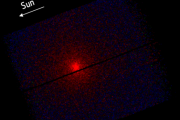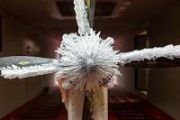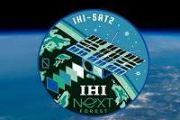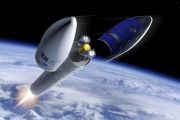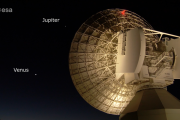
Copernical Team
QuantX Labs and SmartSat CRC accelerate the development of an orbiting space clock
 SmartSAT CRC today announced $1 million to assist QuantX Labs in the development of its optical atomic clock satellite payload that will deliver the heart of a future Australian sovereign navigation and timing capability. This partnership will accelerate the space-qualification and commercialisation of a new type of atomic clock.
QuantX's clock delivers a quantum leap in timing performance
SmartSAT CRC today announced $1 million to assist QuantX Labs in the development of its optical atomic clock satellite payload that will deliver the heart of a future Australian sovereign navigation and timing capability. This partnership will accelerate the space-qualification and commercialisation of a new type of atomic clock.
QuantX's clock delivers a quantum leap in timing performance Search reveals eight new sources of black hole echoes
 Scattered across our Milky Way galaxy are tens of millions of black holes - immensely strong gravitational wells of spacetime, from which infalling matter, and even light, can never escape. Black holes are dark by definition, except on the rare occasions when they feed. As a black hole pulls in gas and dust from an orbiting star, it can give off spectacular bursts of X-ray light that bounce and
Scattered across our Milky Way galaxy are tens of millions of black holes - immensely strong gravitational wells of spacetime, from which infalling matter, and even light, can never escape. Black holes are dark by definition, except on the rare occasions when they feed. As a black hole pulls in gas and dust from an orbiting star, it can give off spectacular bursts of X-ray light that bounce and China's Zhurong travels over 1.9 km on Mars
 The Mars rover Zhurong has traveled more than 1.9 km since it first set its wheels on the surface of the planet in May last year, according to the latest data released by the Lunar Exploration and Space Program Center of the China National Space Administration.
As of Sunday, Zhurong had been operating on the surface of Mars for 342 Martian days at a distance of 240 million km from Earth. A
The Mars rover Zhurong has traveled more than 1.9 km since it first set its wheels on the surface of the planet in May last year, according to the latest data released by the Lunar Exploration and Space Program Center of the China National Space Administration.
As of Sunday, Zhurong had been operating on the surface of Mars for 342 Martian days at a distance of 240 million km from Earth. A Emirates Mars mission discovers new mysterious aurora
 The Emirates Mars Mission, the first interplanetary exploration undertaken by an Arab nation, today released stunning images of Mars' enigmatic discrete auroras, following a series of revolutionary observations that promise new answers - and new questions - about the interactions between Mars' atmosphere, the planet's magnetic fields and the solar wind.
The observations include a never-bef
The Emirates Mars Mission, the first interplanetary exploration undertaken by an Arab nation, today released stunning images of Mars' enigmatic discrete auroras, following a series of revolutionary observations that promise new answers - and new questions - about the interactions between Mars' atmosphere, the planet's magnetic fields and the solar wind.
The observations include a never-bef Farewell to the Torridon Quad - Sols 3459-3461
 We have left the pediment behind and are making our way back to an alternate "MSAR" or "Mount Sharp Ascent Route." We are at the second (of three) observation stops for this area, chosen as they offer the best chance to acquire high resolution images of the structures in the buttes. We have noticed some dark layers which are reminiscent of the lenses at "The Prow" and may indicate changing grain
We have left the pediment behind and are making our way back to an alternate "MSAR" or "Mount Sharp Ascent Route." We are at the second (of three) observation stops for this area, chosen as they offer the best chance to acquire high resolution images of the structures in the buttes. We have noticed some dark layers which are reminiscent of the lenses at "The Prow" and may indicate changing grain NASA's new solar sail system to be tested on-board NanoAvionics satellite bus
 NanoAvionics has been selected to build a 12U nanosatellite bus for an in-orbit demonstration of NASA's Advanced Composite Solar Sail System (ACS3). This a result of a contract between NASA Ames Research Center and AST for a 12U bus to carry NASA's payload into low Earth orbit (LEO) including an approximately 800 square foot (74 square meter) composite boom and solar sail system.
The aim
NanoAvionics has been selected to build a 12U nanosatellite bus for an in-orbit demonstration of NASA's Advanced Composite Solar Sail System (ACS3). This a result of a contract between NASA Ames Research Center and AST for a 12U bus to carry NASA's payload into low Earth orbit (LEO) including an approximately 800 square foot (74 square meter) composite boom and solar sail system.
The aim British rocket company calls for Iceland to grant licence for landmark launch
 British rocket company Skyrora has called on the Icelandic government to grant the licence that would end a months-long delay to Europe's largest-ever suborbital rocket launch, originally set for September 2021. With the launch from Husavik, Iceland - for which it built Europe's largest mobile spaceport - Skyrora had been ready to take a crucial next step towards its goal of completing the first
British rocket company Skyrora has called on the Icelandic government to grant the licence that would end a months-long delay to Europe's largest-ever suborbital rocket launch, originally set for September 2021. With the launch from Husavik, Iceland - for which it built Europe's largest mobile spaceport - Skyrora had been ready to take a crucial next step towards its goal of completing the first Successful test launch a giant leap for rocketry team
 Students of the University of Sydney's rocketry society, the USYD Rocketry Team, have their eyes firmly set on gold after successfully launching their 2022 competition rocket in New South Wales's far west.
After a two-year pandemic hiatus, the team will fly to the US in June to compete at Spaceport America Cup, an international student rocketry competition held annually in New Mexico.
Students of the University of Sydney's rocketry society, the USYD Rocketry Team, have their eyes firmly set on gold after successfully launching their 2022 competition rocket in New South Wales's far west.
After a two-year pandemic hiatus, the team will fly to the US in June to compete at Spaceport America Cup, an international student rocketry competition held annually in New Mexico. New standard will aid in classification of commercial spaceflight safety events
 ASTM's commercial spaceflight committee (F47) has approved a new standard that will help to enhance commercial spaceflight safety. The standard (F3550) provides guidance to space flight operators on classifying safety-related events.
"This new standard will help to classify events based on severity and impact," says ASTM International member Oscar Garcia, chairman and CEO, InterFlight Glob
ASTM's commercial spaceflight committee (F47) has approved a new standard that will help to enhance commercial spaceflight safety. The standard (F3550) provides guidance to space flight operators on classifying safety-related events.
"This new standard will help to classify events based on severity and impact," says ASTM International member Oscar Garcia, chairman and CEO, InterFlight Glob Rocket Lab catches rocket booster returning from space with helicopter
 Rocket Lab (Nasdaq: RKLB) has successfully launched its 26th Electron mission, deploying 34 satellites to orbit. Rocket Lab has now deployed a total of 146 satellites to orbit with the Electron launch vehicle.
The "There And Back Again" mission also saw Rocket Lab complete a mid-air capture of the Electron booster with a helicopter for the first time. After launching to space, Electron's first
Rocket Lab (Nasdaq: RKLB) has successfully launched its 26th Electron mission, deploying 34 satellites to orbit. Rocket Lab has now deployed a total of 146 satellites to orbit with the Electron launch vehicle.
The "There And Back Again" mission also saw Rocket Lab complete a mid-air capture of the Electron booster with a helicopter for the first time. After launching to space, Electron's first 






